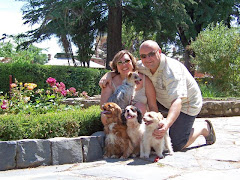I got so caught up in telling you all about the Rooms, I totally didn't include the Signal Hill Tattoo!!!

The Signal Hill Tattoo is an internationally known award winning historical animation program. Each summer, audiences thrill to the echo of the cannon, mortars and musket fire combined with the stirring tunes of the Fife and Drum Band which beckons visitors to a bygone age of 19th Century British military might.
Set atop famous Signal Hill, the Tattoo portrays the garrison life and duties of His Majesty’s Royal Newfoundland Regiment of Foot and the 27th Company-2nd Battalion-Royal Regiment of Artillery who endured the harsh conditions of the Newfoundland Station in the late 1790’s.




 Fifes and Drums
Fifes and DrumsThe fife, drum and bugle were the three popular signal instruments of military service in the late 18th century. Those who played them were all referred to as drummers. These three instruments were chosen because their loud and distinctive sounds are audible even amidst the sounds of battle, and signallers were key to good communication on the battlefield.
In general, drummers were sons of soldiers who were on strength with the regiment, but anyone showing a talent or inclination for this job was likely accepted. Under the direction of the Drum Major the drummers would learn the appropriate rudiments and tunes. Young boys were considered the best candidates for this job because learning the drum was a skill best taken on while young and while the wrists were still supple. The drummer was paid more than a regular soldier as he held a role that was more specialised and entailed greater responsibility.


Quidi Vidi Battery
Given its relative proximity to the harbour entrance of St.John’s, Quidi Vidi was probably the site of some of the Colony’s earliest defence works as it formed a natural part of the outer ring of defenses of St.John’s. It’s most prominent role however was in the events surrounding the capture of St.John’s by a French force in 1762.
The Quidi Vidi Battery was reconstructed in 1967 to resemble a British Coastal Battery of the turn of the century period.
In 1967, the 56 Field Engineer Squadron decided to rebuild the Quidi Vidi Battery as a project to mark Canada’s Centennial Year. All that remained of the original site was partial sections of the foundation which were uncovered in the initial digs. Exploratory trenches were dug in order to determine the outline of the original facility.
Excavated materials were screened for artifacts and the process of clearing the overgrowth was begun by up to twenty sappers a day.
The Guard House, which measured 30’ X 15’ was rebuilt. Many of the bricks found on the site were used to reconstruct the fireplaces, ovens and chimneys. Doors and fasteners were forged at a local foundry.
Having completed the Guard House, the Engineers next laid the gun deck constructed of two by eight planking butted with ten inch square timbers. The gun platform, when completed, measured seventy feet by twelve feet and featured four gun ports where two carronades and two six pound cannons were mounted. Finally the powder magazine was completed with fourteen inch thick concrete walls and a reinforced wooden door.







No comments:
Post a Comment